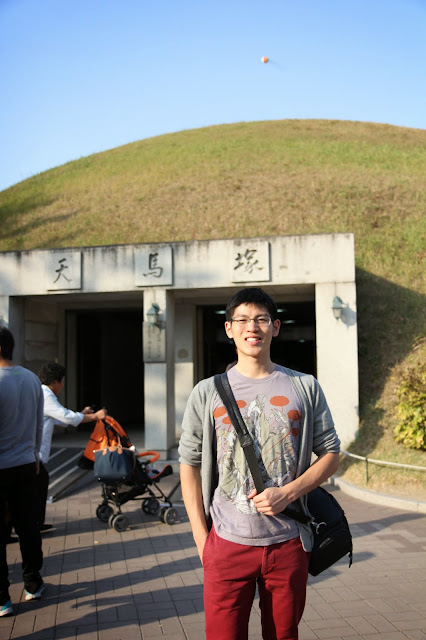Continuing the tour of Gyeongju from the Fulbright Fall Conference!
It is now Sunday after lunchtime, and everyone has stuffed their faces full of bulgogi, and it's warm and bright out. So when we arrive at a museum housing artifacts excavated from tombs dating back to the Silla Dynasty (57 BC to AD 935), we all just kind of casually wander through it and snap photos at pretty crowns, jewelry, and pottery. In fact, as I stroll from exhibit to exhibit with Jason, Katelyn, and Jake, all of us are actually engaged in a conversation about our favorite versions of the Pokémon games. (Mine is probably Crystal.) I also busy myself trying to read the Mandarin on the exhibit descriptions. My Mandarin is very rusty, but any chance is worthwhile! I can only recall two things, though: Gyeongju (경주) is 慶州 (Qìngzhōu), "Celebration City", and Silla (신라) is 新羅 (Xīnluó).
 |
| A crown in the unique style of the Silla period. It looks like it's made of gold leaf, and it also looks like it was made for a very large head. The little jade jelly bean ornaments make me giggle. |
A lot of folks finish the museum early and are just lying on the grass outside beneath the sun. I feel like singing, or maybe napping. We board the bus to go to Anapji, a Silla palace built in the 7th century. Once there, we are given forty-five minutes to walk around the pond, but seriously? This place is gorgeous. Can we just stay here forever, etc. There is a large wooden scale model of the ancient palace complex that everyone photographs before starting the leisurely stroll around the park. The water is absurdly green, but despite the algal blooms, we see giant koi swimming comfortably around.
 |
| Katelyn and me at Anapji Pond. (Taken by Jason) |
 |
| This probably doesn't help their tourism industry much, does it? |
But the star-gazing tower itself, despite all the boasting a guidebook can put forth regarding its numerological perfection and structural symbolism, is rather dull. It's really just a giant rook in the middle of a field that nobody is allowed to visit. See the sign?
Haha, I kid. It's actually a poor translation; the small placard reads, in Korean, "들어가지 마세요," or "Please do not enter." It's referring to the grassy area.
Even so, we walk around the entire thing and realize that there's no door, only a window. The thing must have only been accessible by ladder... Nothing else to see here.
 |
| At Cheonmachong. The balloon way in the background is from the 떡 festival. |
A path leads us past giant earthen mounds -- more like small hills -- that are all just a little bit too geometrically perfect to be natural. They are tumuli, each one a tomb for some member of the Silla royal family. They look like they would be so much fun to sled down come wintertime, but no one is allowed to step foot on them. No visitors allowed. Only lawnmowers to keep them looking pristine.
The very last one at the end of the path is Cheonmachong (천마총/天馬塚), the Heavenly Horse Tomb. It's named after a painting of a pegasus found during the tomb excavation. Now, visitors are allowed to walk inside to see some neat artifacts from the 6th century, but it's all artificial, like a small museum instead of an actual excavation site.
A lady gives a short introduction to the tomb right outside of the entrance, and asks a trivia question: "Why do you think the king's body was placed facing the east?" I answer without even thinking, "To face the sunrise". To my surprise, the tour guide herself seems surprised, and wonders how I knew that. I shrug; it seemed logical. By then, the afternoon has worn on and it's nearing dinnertime. I'm tired, but in a good way, I think, because although my feet are sore I feel like I've had a really fun, chill day.
red light sauna
ReplyDeleteWAJA sauna is specialist manufacturer of top quality sauna products. Products include sauna rooms, steam rooms, barrel saunas, wooden hot tubs, and all kinds of sauna accessories.